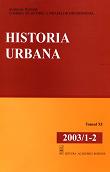Catagrafia Bucureştiului din anul 1810. O nouă lectură (I)
The Census of Bucharest from 1810. A New Lecture (I)
Author(s): Oliver VelescuSubject(s): History
Published by: Editura Academiei Române
Keywords: Census; Bucharest; 1810
Summary/Abstract: In 1810, during the Russian occupation of the Roumanian Principalities, the military commandement orders an extended and detailed taking the census of the country, which had to be fulfilled by local ecclesiastical authorities. At the end, after some hesitations, concluded with the deposition of both Roumanian metropolitans, the census was ended in the autumn of 1810. The hard laboured documentation of these census is deposited at the Roumanian Academy`s Library and was partially published for different countries (judeţe) or cities from Roumania. In 1908 historian Alexandru Lapedatu published the section about Bucureşti under the title „Catagrafia bisericilor bucureştene a 1810” (The census of churches from Bucureşti in 1810). This documentation interested only those which studied the ecclesiastical history of Bucureşti, and, in the historiograhy of the capital city was signaled the value of this document as a demographical source and of general interest for Bucureşti history without ever beeing analised in detail. The actual study is different from the text published in 1908, because it tries, by a new lecture, to order so the documentat`s content as by a quantity analyse the datas furnished to be put in a new light. As a result are overlighted social facts, human types and elements of psichology of the communities from the early XIXth century. The study was structured in eight chapters, as follows: I. The citie`s adult population. The content of the census was restructured using the size criteria, by this method resulting the most inhabited parishes (mahalale) of the town. So was determined the total population of Bucureşti: 32,418 inhabitants. II. The dwellings. Their aspect and their number. Here were compared the datas from 1798 Census and from 1810 Census. From better knowing the number houses were used the notes made by foreign travellers in Bucureşti, all underlining the rural look of the town. In 1810 in Bucureşti were listed 7,503 dwellings. III. Urban density in Bucureşti. Taking into account citie`s characteristic pattern, houses in the middle of large gardens, the density resulted by dividing the number of inhabitants to the number of dwellings. The average of urban density in Bucureşti was 4.28%. IV. The priests and their families. The ecclesiastical body beeing the main subject of the Census, its statistical situation was of real interest. The tables revealed that in Bucureşti were 246 priests, and 1 priest deserved 132 inhabitants. In the meantime was analised the composition of priests` families, the number of children, wives age, and, what is pregnant it is the large number of widows, reported mainly to wives age and the number of children. V. The mortlity. Endemic diseases and post birth infections were the main causes of mortality, the moffected beeing both the female population and the children. Statistical datas were confronted with other sources, anthropological (osthological). VI. The education and the state of culture.
Journal: Historia Urbana
- Issue Year: XI/2003
- Issue No: 1+2
- Page Range: 195-213
- Page Count: 19
- Language: Romanian
- Content File-PDF

